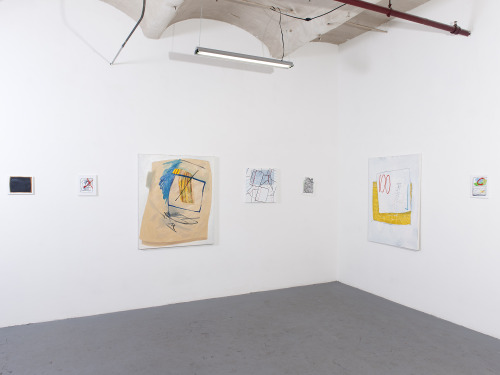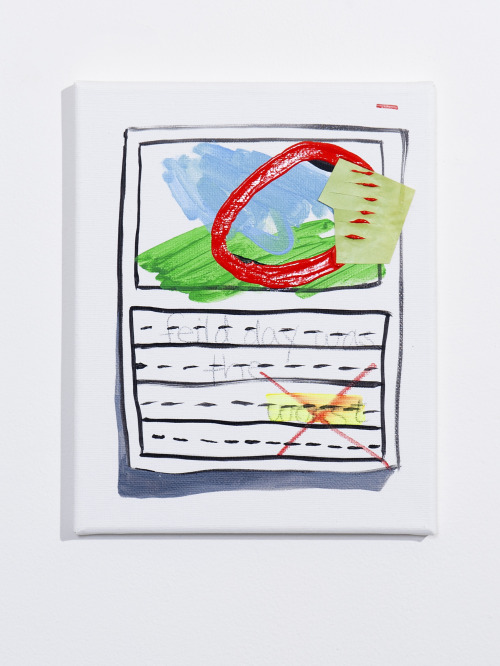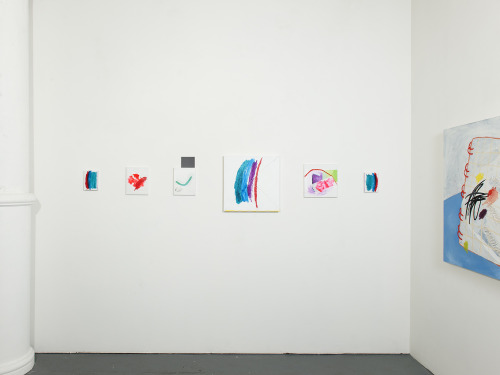Joseph Shaikewitz

The double entendre behind the title of Angela Arrigo’s current show “College Ruled” at Lil’ Gallery is enough to spark my interest. Taken as a declaration, the phrase affirms the exhausted adage that college “could be the best four years of your life.” (Looking through the artist’s past work, a series titled “What Loans?” dares to suggest otherwise.) At the same time, the exhibition title recalls the college ruled notebook paper that one eventually acquires for note taking or mindless doodles. In that reading, the narrower spaces for scrawling text might insinuate maturity and seriousness—an academic coming-of-age.
Whether an homage or an affront, Arrigo’s newest series of work confronts the nearly countless days spent in the confines of the classroom in the oftentimes imposed pursuit of an education. The one-room gallery features a suite of paintings that function as vignettes of a homogenous school system, strewn with motifs of graded assignments, manila folders, impasto scribbles, and a folded love note. Throughout the exhibition, the artist demonstrates an impressive ability to translate her subtle forms across dimensions; pockets of 5×7” surfaces hold their own among the smattering of large-scale paintings.
A recent MICA graduate, Arrigo approaches her college years and those that preceded them with an ounce of nostalgia. Scenes of elementary school prompts, wide-open journals, and a blank blackboard actively recall the image of docile students seated behind desks. In the corner furthest from the entrance, a grouping of six small paintings intimate a childlike point of departure for this body of work. The saturated palette simulates a fresh pack of Crayola markers while the swift brushstrokes reinforce the innocent spontaneity of youthful, naïve mark-making.

At times, the literal depiction of iconic school supplies falls short in communicating the actual complexities of navigating an education. Such is the case with three small canvases that initiate the exhibition. Each portrays a quiet stack of lined and plain loose-leaf paper that establish the picture plane as a quasi-desktop. However, the depictions of these unmarked pages and circular reinforcement labels verge on banal in the context of the expressive character and narrative imagination that animate the works alongside them.
“field day was the worst” is one such highlight—a particularly endearing image that puts forth a rebellious, albeit anodyne renouncement to which I find myself silently agreeing. The canvas is separated into two smaller tableaus. The top half reveals a simplified landscape—juvenile swaths of pale blue and green—overlaid with a brazen red circle and a small, incised cut-out. The title of the work is scrawled in pencil in the lower register within the lined format of a handwriting worksheet. If we take this to be a graded assignment as several markings suggest, then the instructor takes offense with the quiet protest of the word “worst”—highlighting and crossing it out with a definitive ‘X’–rather than the flagrant misspelling of the word “feild.” The work appears to poke fun at a system where freethinking and defiance are stifled more quickly than legitimate errors. The subtle rebellion of the composition contributes to the overarching wit of the exhibition where similarly tacit marks encourage close looking and careful reflection.

Perhaps even more compelling than Arrigo’s caricature of the classroom setting is her inspired handling of medium. Her pieces incorporate thick, at times calligraphic impasto lines atop expressive painterly forms. In many of the larger compositions, the textured brushstrokes and now-muted colors of previous paintings bleed through the gessoed surface, alluding to the material lifetime of each object. If painting functions as a record of memory, then Arrigo’s applications of protruding acrylic paint and collage over multilayered and somewhat concealed surfaces metaphorize that very process. The temporal layering of images and viscosities underscores the act of looking back, the polemics of memory, and the allure of nostalgia. The memorializing brushstrokes bring to mind a range of fellow painters ranging from Philip Guston to Liat Yossifor, while the question of painting’s materiality and its relevance to a contemporary moment seems inspired by artists like Trudy Benson, Laura Owens, and Eric Sall. Amid such comparisons, Arrigo’s work emerges as a reflection on the past with a gloss of its material excavation.
If college did indeed rule, then its presence continues to linger in the present. For Arrigo, the act of parsing out this moment creates a likely thematic commonality between artist and viewer and hosts a keen exploration into the essence of painting. While in rare instances this plays out in conceptually sophomoric terms, Arrigo’s new series of work demonstrates a clear painterly perseverance that is anything but elementary.
Photos courtesy of Lil’ Gallery